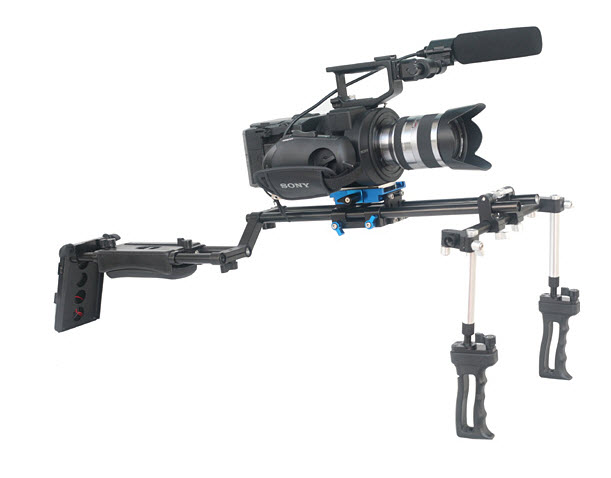
As a vital piece of filmmaking equipment, anybody who is seriously thinking about directing a film should first learn how to properly use a shoulder rig.
Whilst shaky-cam and found footage films may have their moment, when it comes to effectively capturing clear and stable point voyeuristic shots whilst on the go, using a shoulder rig is the ideal mobile solution.
What Is A Shoulder Rig?
In short, a shoulder rig is a piece of equipment that moves alongside the cameraman. It allows filmmakers to capture movements, and to travel with their subject matter, whilst still keeping the camera relatively stable; thus increasing the efficiency of the production.
When compared to their older and much more cumbersome counterparts, many modern video cameras are extremely light and easy use. Although this makes them perfect for capturing handheld footage, if they are used without the proper stabilization many of the shots caught on film will be too jittery and skittish, making them practically unusable.
Although a shaking camera can be used to give the impression of rapid motion, too much shake can disgruntle your audience and spoil the film. If done poorly, shaky footage can prove distracting and even nauseating for viewers, drawing them out of the story.
Instead of jerky, unpleasant movements, filmmakers need to create smooth, planned motions and give their camera an almost feather-weight feel as if the viewer is floating along with the subject matter. You’re certainly not going to achieve that by holding the camera in your hands.
Small, sensitive cameras are in need of stable, well-balanced support and that is where a shoulder rig becomes invaluable.
Why Would You Need One?
 Whether or not you’re going to need this equipment depends on exactly what kind of footage you’re looking to capture and the story you want to tell.
Whether or not you’re going to need this equipment depends on exactly what kind of footage you’re looking to capture and the story you want to tell.
Using a shoulder mounted camera is great way to capture footage from a narrative view. It puts viewers directly into the heart of the action; much like a disembodied spectator and it allows the art of voyeurism to be carried out from directly where you want it to be seen.
The rapid, yet still controlled, movement of the camera can also help build the energy of the scene, adding an extra frantic touch to what would otherwise be a mildly heated moment.
How To Choose A Suitable Rig
Not all shoulder rigs are created equal, and many have different purposes or specifications depending on the camera being used. There are quite a few things you need to consider before investing in any old setup.
Firstly you’ll need to consider which camera you’re going to use, and research which rig is best suited for that use. If you’re shooting with a larger camera then you’re going to want something that has a suitable shoulder mount to balance the weight (which we’ll cover in more detail below).
Lighter camcorders and DSLRs will also have their own specific types of shoulder rig. Be sure to check which types of cameras are supported before you make a purchase.
It’s also worth checking if it can accommodate extras and add-ons. Many will allow accessories such as monitors, microphones, battery packs or even an articulating arm. Being able to add or subtract features from your rig on the fly will help enhance your filmmaking experience.
Balancing The Rig
Shoulder rigs are supported using a combination of your arms and your shoulder. If it is not balanced properly, the weight of the rig and the camera combined will push it forward, leaving you to support the entirety of the set up with your arms.
This set up will please nobody, as the footage won’t be captured at its best possible level and the cameraman will feel exhausted even after just short periods of filmmaking. In order to fix this problem you’ll need to create a counterbalance; something that will even out the weight and make filmmaking a much more comfortable and stable process. This can be achieved by loading weight onto the back of the shoulder mount so that it cancels out the top-heavy weight of the camera equipment.
You can purchase equipment that allows you to add extra weights as you see fit, or you can get creative and use accessories such as battery packs to help even the load.
We’d also recommend using an off-set shoulder mount, so that you can keep the camera lens in front of your eye level instead of having to peer to the left or the right. If your rig is starting to tilt or you find yourself drifting towards one particular direction you can also use weights to re-centre your setup.
But of course you cannot solely depend on weights for support. You can ensure further stability in your shoulder rig by increasing the points of contact the equipment has with your body. The rigs connection to your shoulder acts as the main point of contact, whilst both your hands make two other very firm points. The final point of contact comes as you lean into the lens, resting your eye against the camera and, in turn, the camera against your eye. You then have four complete points of contact which help create a stable filmmaking environment.
Operating A Shoulder Rig
Operating this equipment properly requires a steady and gentle approach. If you’ve taken the time to ensure that the rig is properly balanced and that everything is securely in place then you should be able to move with it and manoeuvre yourself for each shot without causing unwanted disruption to the footage.
The key to keeping in sync with subject matter when on the move is to walk softly, letting your knees bend naturally and rolling on the balls of your feet with each small step rather than stomping around. Even if you need to quickly move from one stop to another, try not to make any unnatural movements. Be hyper-aware of your surroundings before you take a step in any direction and check that you’re safe to move around with no obstacles in your way. Ideally, you should be like your subjects shadow, effortlessly following their every movement and flowing around them as they perform in front of you.
Hopefully this guide has presented you with plenty of useful advice, and you’ll now be much more informed when it comes to choosing and using your first shoulder rig. Why not use the comments section below to tell us about your experiences, and what kind of set-up you prefer using?
Author bio:
This article was written by Andrei Kaminsky on behalf of GripUp.com. The one stop shop for all your video camera and DSLR equipment needs.

